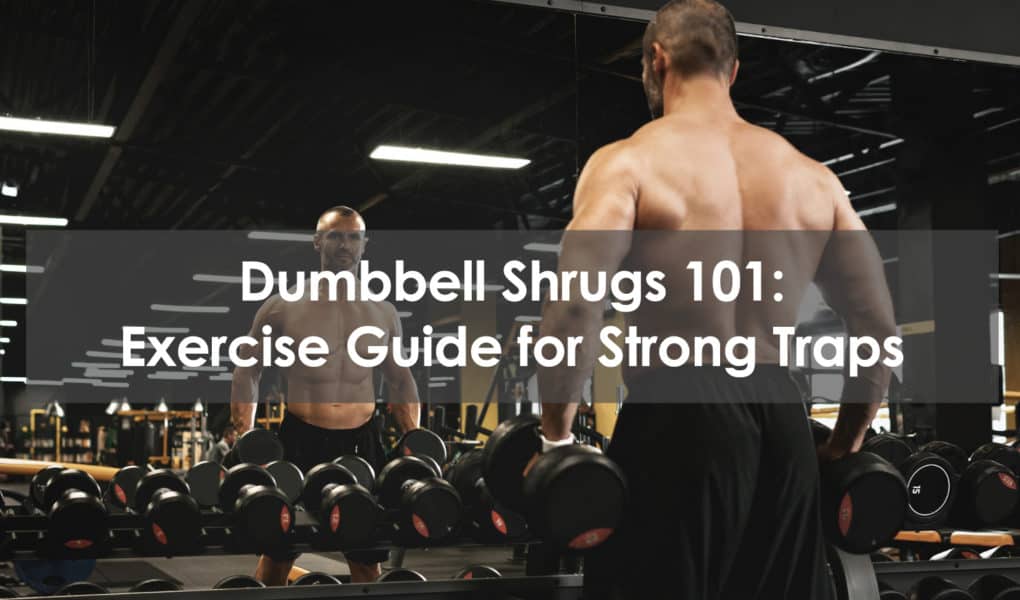Dumbbell shrugs are a very simple, yet very effective exercise that targets your trapezius muscles and shoulder muscles – all with just a pair of dumbbells and very small movements.
They’re a great addition to any upper body workout as they can properly target those hard-to-reach muscles, and they’re not too difficult to learn either. That being said, there are some points to be aware of to ensure you’re performing dumbbell shrugs correctly.
Here, we will look at dumbbell shrugs in more detail, outlining their benefits, how to perform them correctly and how you can modify them to meet your needs.
Benefits of dumbbell shrugs
Like many upper body exercises, you’re not leaving the standing position when performing dumbbell shrugs. In fact, you’re not making much of a change from the initial starting position either, meaning they are a relatively easy move to master.
So, they’re an effective exercise for beginners and experts alike.
Interestingly, dumbbell shrugs can also help you develop proper posture. Many people, particularly those who work at a desk every day, tend to develop a slight hunch in their upper back, but dumbbell shrugs can help rectify this by strengthening muscles in that area and equalizing the balance between the muscle groups there.
So, if you’re suffering from work-related neck pain or perhaps you’re just looking for simple exercises for neck pain, you won’t find much better than dumbbell shrugs.
A dumbbell shrug is also a very effective trap exercise. Your traps can be a particularly stubborn muscle and one of the more difficult ones to target, which is why shrugs are often so popular.
As an isolation exercise, the dumbbell shrug is specifically targeting your traps as the primary muscle – there are very few exercises that do this.
Muscles worked
As mentioned, the primary muscles used in this exercise are your trapezius muscles, which sit on either side of your neck.

Although these aren’t some of the larger muscles in the body, they are frequently used in compound movements and they can be rather impactful in improving your overall size, as your traps become prominent when built up.
Stronger trapezius muscles can help with exercises like squats, deadlifts, and military presses.
In terms of secondary muscles, quite a few are activated by the dumbbell shrug. Your shoulder muscles and some of your upper back muscles – more specifically the rhomboids – are engaged. It’s a particularly good exercise for adding shoulder strength.
Likewise, your abdominal muscles will be working to keep your upper body stable while performing the movement. Given the nature of shrugs, they only work upper body muscles, so don’t expect any part of your legs to be engaged.
How to perform dumbbell shrugs
- Stand straight holding a dumbbell in either hand by your side with your palms facing inward toward each other. Your arms should be straight with a slight bend in the elbow.
- Keeping your spine neutral, contract your traps, and bring your shoulders up toward your ears. Squeeze your traps at the top and hold for a moment.
- Release the tension and slowly lower your shoulders again to return to the starting position. Repeat for 10-12 reps.
Tips
- The range of motion for dumbbell shrugs is relatively small, so don’t try to extend it or raise your shoulders unnaturally high.
- There should also be no explosive movements here; this is a controlled exercise that should be executed at a steady and consistent pace. You must also avoid any excessive jerking motions – if you find that you need to do this in order to lift the weight up, then use lighter dumbbells that allow you to perform the exercise safely and correctly.
- To keep your spine neutral, pull your shoulders back and engage your core.
Mistakes to avoid
- Try not to allow your shoulder muscles and upper back muscles to do the work; remember that shrugs should be isolating your traps (as this is an isolation exercise), so make sure these muscles are producing the force.
- Do not try to lift too heavy – it might feel like you’ll be fine with a certain weight, but too much work with it can cause injury and muscle strain.
Variations
You can perform dumbbell shrugs while seated on a chair or bench, or even kneeling on the floor. By changing to this position, you’re providing yourself with slightly more stability, which allows you to move through various levels of strength.
You could also use lighter weights on a barbell to perform an overhead dumbbell shrug. Lift the bar above your head as if you were going to perform an overhead press. Then, contract your traps to squeeze your shoulders up slightly, then lower back down to the starting position.
Really, any sort of dumbbell shrug that’s performing that upward motion will target your traps and other relevant muscles.
Final Thoughts
Adding dumbbell shrugs to your workout routine is an excellent way of targeting muscles like your traps that tend to be overlooked as they are more difficult to isolate.
Dumbbell shrugs also have benefits outside of improvements in strength as they can help to solve problems with your posture and can even alleviate neck pain in some instances.
Considering that shrugs are also a relatively simple exercise, then it’s clear to see why they have become such a popular choice for gym-goers.
Frequently Asked Questions
Can you do shrugs with a barbell?
As mentioned, you can perform overhead dumbbell shrugs with a barbell, though the traditional movement will be more difficult as the weight will be slightly in front of your hips rather than in line with them.
This means your spine won’t be completely neutral when you’re performing the exercise, thus reducing its benefits and risking injury.
Should shrugs be heavy?
As with any resistance exercise, dumbbell shrugs should challenge you but not be so much of a strain that your form is affected. Start with lighter weights and see how you feel; you should be able to safely perform every rep, though the last few of each set will be particularly challenging.
As an isolation exercise, dumbbell shrugs don’t need excessive weight in order to be effective for the targeted muscle group.
Can you train traps every day?
In order to see progression in a particular muscle group, it should be trained 2-3 times a week. It’s best not to target the same muscles every day because recovery is an essential part of your fitness journey; it is when the change in muscle composition happens.
So, trap workouts should be spaced out evenly during the week.







